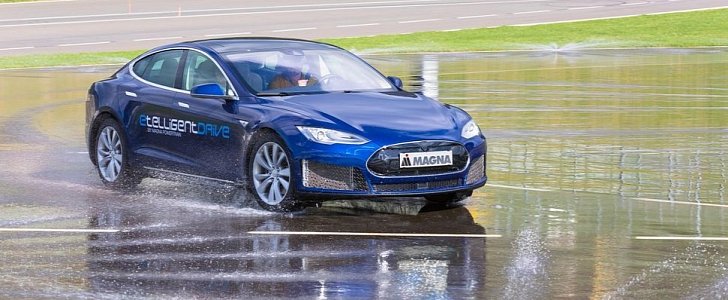After everything this electric sedan has done, not many companies would have the nerve to think they can improve it. Sure, give it to Audi, BMW or Mercedes-Benz (or any other traditional premium manufacturer), and you'll get a much better interior, but as far as its powertrain goes, nobody would dare touch it.
There are countless videos on the Internet showing just how good the Model S is at delivering its power in a useful manner, teleporting itself off the line with zero wheel spin as if the laws of friction were on holiday. But all these clips have one thing in common: they focus on the vehicle's speed in a straight line.
What about those moments when the asphalt veers left or right? For a car this heavy, the Model S does surprisingly well, and that's mainly due to the battery pack (accounting for most of the load) being situated under the floor. With a center of mass so low, there's minimal body roll, and the EV feels planted.
Could the handling be improved, though? Magna, the Austrian automotive parts and equipment supplier, believes so, and it has a prototype to prove it. It's called the Magna E1, and it used to be a pre-facelift Tesla Model S. These days, it fully deserves its new name as Magna has taken out the two original motors of the EV and replaced it with three of its own.
The new ones - spread two at the back and one in the front - develop 188 hp each for a total 564 hp, but it's not the power itself that counts, but how it gets to the wheels. Each of the two motors in the rear drives its corresponding wheel, meaning the system allows for easy torque vectoring.
As we all know, torque vectoring works by actively shifting the amount of power between the two wheels at the back (in this configuration) depending on the situation. For instance, when the vehicle is negotiating a right-hand turn, the left wheel will receive more torque, helping to get through the bend more safely and at greater speeds.
According to CNET, Magna says its system is easily integrated into any chassis with just 12 to 18 months of development time. Any car company interested, however, has a wider range of options available, with Bosch being the first Magna competitor that springs to mind.
Even though Magna chose a Tesla Model S as its testbed vehicle, the Californian company is the least likely to request its services. If anything, it would probably hire a few of its engineers and develop everything from scratch in-house. That sounds more like Elon Musk's MO.
What about those moments when the asphalt veers left or right? For a car this heavy, the Model S does surprisingly well, and that's mainly due to the battery pack (accounting for most of the load) being situated under the floor. With a center of mass so low, there's minimal body roll, and the EV feels planted.
Could the handling be improved, though? Magna, the Austrian automotive parts and equipment supplier, believes so, and it has a prototype to prove it. It's called the Magna E1, and it used to be a pre-facelift Tesla Model S. These days, it fully deserves its new name as Magna has taken out the two original motors of the EV and replaced it with three of its own.
The new ones - spread two at the back and one in the front - develop 188 hp each for a total 564 hp, but it's not the power itself that counts, but how it gets to the wheels. Each of the two motors in the rear drives its corresponding wheel, meaning the system allows for easy torque vectoring.
As we all know, torque vectoring works by actively shifting the amount of power between the two wheels at the back (in this configuration) depending on the situation. For instance, when the vehicle is negotiating a right-hand turn, the left wheel will receive more torque, helping to get through the bend more safely and at greater speeds.
According to CNET, Magna says its system is easily integrated into any chassis with just 12 to 18 months of development time. Any car company interested, however, has a wider range of options available, with Bosch being the first Magna competitor that springs to mind.
Even though Magna chose a Tesla Model S as its testbed vehicle, the Californian company is the least likely to request its services. If anything, it would probably hire a few of its engineers and develop everything from scratch in-house. That sounds more like Elon Musk's MO.

